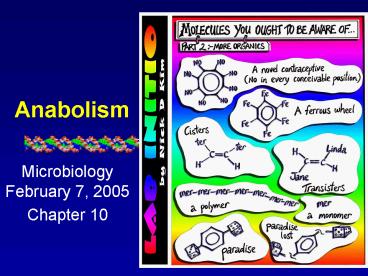Anabolism - PowerPoint PPT Presentation
1 / 10
Title:
Anabolism
Description:
What to do with energy generated from respiration, photosynthesis or fermentation? ... chemolithotrophs - oxidize inorganics for energy, use some of this energy to ... – PowerPoint PPT presentation
Number of Views:672
Avg rating:3.0/5.0
Title: Anabolism
1
Anabolism
- Microbiology February 7, 2005
- Chapter 10
2
Anabolism overview
- What to do with energy generated from
respiration, photosynthesis or fermentation? - Synthesize sugars
- Calvin Cycle, gluconeogenesis
- Synthesize other building blocks
- assimilation of N and S
- amino acids, nucleotides, lipids
- Synthesize Macromolecules
- peptidoglycan
- proteins, nucleic acids
3
Autotrophy Carbon Fixation
- reduction from inorganic CO2 to organics
- requires energy (ATP) and reducing power NAD(P)H
- How do organisms do it?
- chemolithotrophs - oxidize inorganics for energy,
use some of this energy to reverse e- flow and
reduce NAD(P). - anoxygenic phototrophs
- non-sulfur - cyclic photophosphorylation for
energy, use energy to reverse e- flow (from
succinate) and reduce NAD(P). - Rhodobacter - sulfur bacteria - cyclic photophosphorylation for
energy, non-cyclic e- flow (from inorganics) to
reduce NAD(P) - Chlorobium
4
Autotrophy Carbon Fixation
- oxygenic phototrophs - non-cyclic (from H2O)
photophosphorylation for energy, non-cyclic e-
flow (from PS II) to reduce NAD(P) -
cyanobacteria, prochloron - water split, donates electrons to P680, oxygen
produced - P680 excited, electrons passed to pheophytin,
quinones, cytochrome, plastocyanin, P700 - P700 excited, electrons passed to FeS protein,
ferredoxin, NADP
5
Calvin Cycle
- What is the most abundant enzyme on earth?
- What is it's other claim to fame - poor
efficiency - 2 CO2 fixed/sec. Why? - Enzyme evolved before oxygenic photosynthesis -
reducing atmosphere -oxygen causes side reaction - Carbon fixation (autotrophy) - Calvin cycle in
most organisms - RUBISCO - ribulose bisphosphate carboxylase
oxygenase - 6 RuBP (5C) 6 CO2 --gt 12 phosphoglycerate
--gt--gtF-6-P (6C) 6 RuBP - reactions similar to pentose phosphate pathway
- Synthesis of 1 glucose requires 18 ATP, 12 NADPH
6
Gluconeogenesis
- Synthesis of sugars from pyruvate or TCA cycle
intermediates (oxaloacetate) - Reverse of glycolytic reactions except for key
regulated steps - Pyruvate --gt PEP
- F-1,6, bis-phosphate --gtF-6-phosphate
- Glucose-6-P --gt glucose
7
Sulfur Metabolism
- Sulfur - sulfate activated by linking to adenine
nucleotide to form PAPS. - Used to synthesize cysteine after reduction to
sulfide.
8
Nitrogen metabolism
- Different Nitrogen sources
- from ammonia - aKG?glutamate?glutamine pathway
followed by transamination reactions (nitrogen
currency) - from nitrate - Assimilatory nitrate reduction
(using NADPH), via nitrite. - Nitrogen fixation N2?ammonia Azotobacter,
Rhizobium, cyanobacteria
9
Peptidoglycan synthesis
- Sugars are activated for polysaccharide
synthesis by linking to a nucleotide(e.g.
UDP-glucose) - Activated sugars are then often modified
- Amino (glucosamine)
- Acetyl (N-Acetyl glucosamine)
- Carboxylic acid (N-acetyl muramic acid)
- Peptidoglycan building blocks synthesized on
bactoprenol carrier.
10
Peptidoglycan Synthesis
- Recycling of bactoprenol inhibited by antibiotic
bacitracin - Transpeptidation varies between gram and gram
- Inhibited by penicillin
- New peptidoglycan synthesis occurs mainly in
septal area































